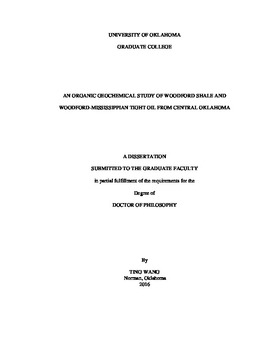| dc.description.abstract | A comprehensive organic geochemical analysis was performed on a suite of core samples from the Woodford Shale in Central Oklahoma with the aim of characterizing variations in organic matter source, depositional environments and thermal maturity. A total of 30 oils and condensates produced from the Woodford Shale and Mississippian Limestone in Central Oklahoma were analyzed to determine the origin of these liquids. A total of 168 core samples containing the Woodford and Mississippian sections from 14 wells were subjected to total organic carbon (TOC) and Rock-Eval analysis for geochemical screening, and one sample from each well was analyzed for vitrinite reflectance (%Ro) measurement. Rock samples with good source rock potential (TOC>1.0% wt.) were selected for biomarker and isotope analyses. These analyses were carried out by means of gas chromatography (GC), gas chromatography-mass spectrometry (GC-MS), and gas chromatography-mass spectrometry- mass spectrometry (GC-MS/MS).
Based on the organofacies classification of Pepper and Corvi (1995), the Woodford Shale in this study is a typical marine siliciclastic mudstone (organofacies B), which is supported by the evidence described herein. TOC and Rock-Eval parameters show that the Woodford Shale has excellent source rock potential and is dominated by Type II kerogen indicating a marine origin. Distributions of regular steranes, hopanes and monoaromatic steroids (MAS) point towards a marine siliciclastic depositional environment. Aryl isoprenoids and paleorenieratanes/isorenieratanes suggest the occurrence of episodic periods of photic zone anoxia (PZA) during deposition of the Woodford Shale in this study. In addition, n-alkanes, steranes distributions, and the tentative identification of gammacerane suggest deposition under hypersaline conditions in Central Oklahoma. Source-dependent biomarker parameters indicate that in the area in the proximity of the Nemaha Uplift, the Woodford Shale was deposited under a condition rich in clay content, reflecting the influence of the paleo-Nemaha Uplift. Thermal maturity parameters indicate that the Woodford Shale is immature to marginally mature in Payne County, and shows a progressive increase in maturity towards the southwest following the regional dip. In the area in the proximity of the Nemaha Uplift, the Woodford Shale is in the main stage of oil generation.
Geochemical logs of Pritchard-1 well show a minimal range of vertical variation within the Woodford Shale in this study. The Woodford Shale in this study was subdivided into middle and upper members without the lower member being present based on the integration of geochemical and geological data. The middle Woodford member has the higher TOC values. Pristane and phytane (Pr/Ph) and biomarker ratios suggest the establishment of stronger anoxic conditions during deposition of the middle Woodford member than the upper Woodford member, where the latter may have received an additional siliciclastic organic matter input. In the area in the proximity of the Nemaha Uplift, Pr/Ph ratios indicate deposition under suboxic to dysoxic conditions for the Woodford Shale interval analyzed. Isotope data indicates a marine organic matter source for the Woodford Shale, but δ13C values do not show significant variations in organic facies, depositional environment, or thermal maturity.
Three conclusions regarding the origin of the liquids in this study are: (i) oils produced from the Woodford Formation and that from the overlying Mississippian Formation share very similar fingerprints suggesting the Woodford Formation and the overlying Mississippian Formation are connected; (ii) oils produced in the area in the proximity of the Nemaha Uplift (Logan and West Payne Counties) were not only Woodford sourced but also had a Mississippian source contribution based on the presence of abundant extended tricyclic terpanes and other source specific biomarker fingerprint characteristics; (iii) oils sampled from the East of the Cherokee Platform (Central-East Payne County) share strong Woodford source characteristics but were not generated in-situ from the Woodford Shale, which is not mature enough in that area, but probably migrated from the Woodford Shale in the deeper part of the Anadarko Basin in Southern Oklahoma. The results of this research are consistent with some new findings reported by Devon geologists that abundant marine coarse-grained biogenic silica (radiolarian-rich chert facies) found in Woodford cores (Central-East Payne County) in this area may be a contributor to good reservoir petrophysical properties suggesting the Woodford Formation may not be the source rock in this area but simply a tight reservoir. | en_US |
